





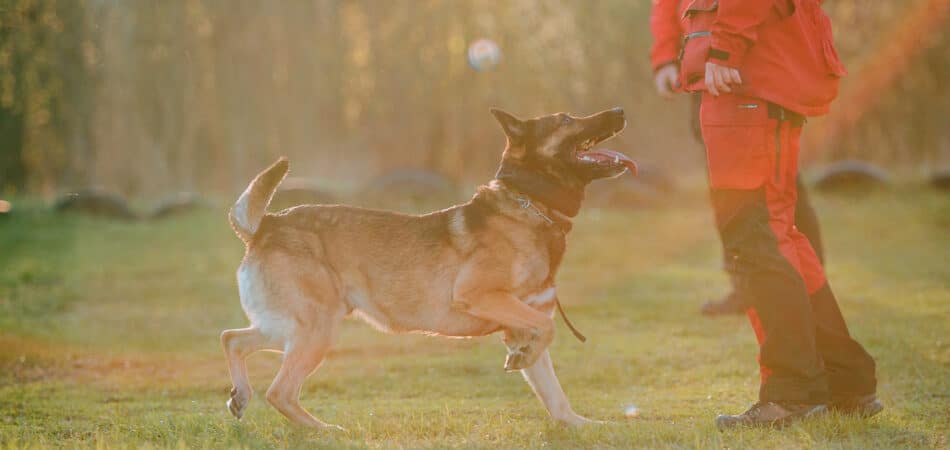
Everyone looks forward to summer vacation or a weekend getaway. But when you’re a protection dog owner, the excitement comes with a little extra baggage. Studies have shown that 37% of dog owners skip out on travel because they simply don’t want to leave their dogs behind.
And if your dog’s job is to guard the place, leaving can feel like walking away from your own peace of mind. After all, who’s going to keep an eye on things while you’re off recharging?
So here we are. You want to trust your dog to guard the house independently—a tall order, but doable with the right preparation. This isn’t some mystical process that only “dog whisperers” can handle.
You just need to lay a solid foundation, train with purpose, and, yes, putting in the work.
Let’s break down what it takes to get your protection dog ready to take charge while you’re away. This will be their job, and it deserves the same dedication they give you every day.
Some dogs seem perfectly fine when you leave them alone, even for just a few hours. Others? Well…not so much. And they might even find it distressing.
According to research, eight out of ten dogs struggle with being alone, though about half of them keep their worries under wraps.
And despite what some people think, this isn’t about “revenge” for being left behind. Most of the time, they’re just feeling the anxiety of separation.
The signs of this anxiety aren’t always obvious. Some dogs:
Often, owners don’t even realize their dog is struggling until they come home to chewed-up items or get a complaint from a neighbor about barking.
Yet even when your home remains intact, your dog may have spent the entire time on edge, silently dealing with the stress.
This can be a serious issue for dogs, but with the right training and management techniques, you can help your dog feel more secure when they’re left alone.
It all starts with easing them into the idea that solo time is normal and, more importantly, nothing to worry about.
How to get started?
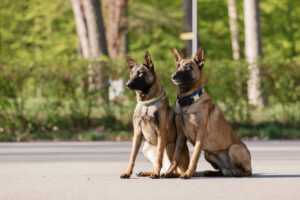
So, you have to start small. Begin by leaving your dog alone for just a few minutes, gradually increasing the time as they get more comfortable.
Try to make your departures and returns low-key—no big fussing or long goodbyes. Just head out the door like it’s a routine. Over time, they’ll start to see that it really is no big deal, and that you’ll always come back.
It’s also helpful to make your absence something they look forward to. You can try leaving them with a special treat or toy that they only get when you’re away.
Puzzle toys, for instance, can keep their mind engaged and make solo time a little more enjoyable. By associating your absence with something positive, you’re slowly rewiring their response to being alone.
Next up, zones. If your dog is going to protect the house independently, they need a clear idea of where their territory begins and ends.
This means setting up designated guarding zones, like the front door, the backyard, or a certain room. Spend time training them to stay in these areas, especially when you’re gone.
You can do this by using commands like “stay” or “place,” followed by a reward when they stay put. Try practicing with short sessions where you leave the room and then return. Over time, they’ll understand that these are their main watch points.
Establishing clear boundaries also helps prevent them from wandering aimlessly around the house, which can be stressful. Instead, they’ll know exactly where they need to be, helping them feel more grounded and focused.
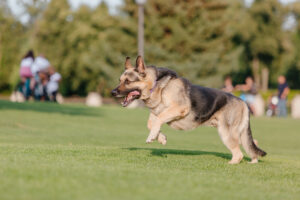
To prevent your dog from jumping at every sound, you need to desensitize them to these everyday noises.
Start by exposing your dog to common sounds they’ll encounter when they’re on solo duty. Play recordings of footsteps, delivery trucks or outdoor noises at a low volume while they’re in their guarding zone.
Gradually increase the volume over time. Praise and reward them when they stay calm, showing them that these sounds aren’t a cause for alarm.
The goal here is to build their tolerance so they can distinguish between harmless noises and real threats.
Your protection dog’s job involves guarding against intruders, so they need to be prepared for encounters with strangers—even when you’re not around to give commands.
It’s crucial to work on controlled exercises where your dog learns to handle the presence of strangers with calm assertiveness.
One way to do this is by enlisting a friend or trainer to act as a stranger. Have them approach the house, ring the doorbell, or make light noises near the entry points.
Observe your dog’s reaction closely. They may alert you by barking, but the goal is to teach them to assess whether someone is a real threat or just an everyday visitor.
Reward them when they stay composed and only react appropriately. Over time, they’ll learn that their guarding duty requires focus—not just barking at every new face.
And don’t forget to…
Start by training your dog to respond to specific cues or alarms that indicate something is wrong.
For instance, you can use a distinct sound—like a whistle or a specific command—that signals to your dog to either alert neighbors, return to a safe space, or remain calm until help arrives.
Another essential emergency skill is teaching your dog to recognize fire alarms or other emergency signals in your home.
Familiarize them with the sound by playing it periodically during training sessions. Reinforce calm behavior and guide them to a designated safe zone within your home.
Lastly, if your dog is trained to use technology, like an emergency alert button or a smart collar, make sure they’re comfortable using it. In case of a break-in or other emergency, your dog may be able to trigger an alert that notifies you or emergency services.
By practicing these responses consistently, your protection dog will be well-prepared to act responsibly and effectively, no matter what situation arises.
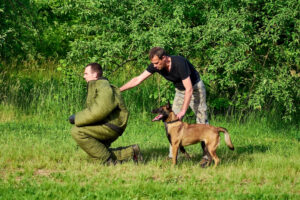
Before departing, make certain your dog has something productive to occupy their time.
Equip them with safe, durable toys, mentally stimulating puzzle feeders filled with tasty treats, or even a long-lasting chew bone.
These diversions will ensure they remain absorbed and content while you’re away.
One of the best ways to test your dog’s readiness is to create a “decoy” situation where they think you’re gone, but you’re actually nearby, watching.
This way, you can see how they react when left “alone” without the pressure of truly being out of reach.
Leave the house as you normally would—grab your keys, lock the door—but instead of heading out for the day, just step out of sight.
Watch from a distance or even use a camera to monitor their behavior. Do they pace, bark, or get antsy? Or do they settle into their role, calmly patrolling their zone?
This exercise gives you valuable insights into their readiness and highlights any areas that might need extra attention.
Rome wasn’t built in a day, and neither is a confident, independent protection dog. Start by leaving your dog alone for short periods, then slowly extend the time as they adjust.
Each time you return, check on their behavior—did they stay in their guarding zone? Were they calm and alert, or did they seem distressed?
Over weeks or months, you can build up to longer absences. The gradual approach makes the process less overwhelming for your dog, showing them that they can handle the responsibility one step at a time.
Cameras, treat dispensers, and smart collars—these tools can feel like cheating, but when you’re miles away, they’re lifesavers.
Use a camera system that allows you to check in, give commands remotely, and observe your dog’s behavior in real-time. This way, you can redirect behavior if needed or just reassure yourself that they’re handling things well.
Remote treat dispensers, by the way, are golden for positive reinforcement. Send a treat whenever they’re calmly surveying their territory. It’s like saying, “Good job,” even if you’re not there to do it in person.
Just remember: tech can supplement training, but it’s not a replacement. Your dog should be able to operate independently of these tools—they’re just there for support.
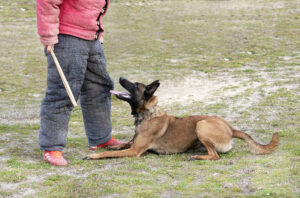
Maybe the couch cushion’s been massacred, or there’s a little “gift” on the carpet.
Tempting as it is to let out a groan (or worse), resist. See, punishment isn’t just ineffective; it’ll just make things worse.
When we get mad at our dogs for misbehaving while we’re out, they don’t link our frustration with what they did earlier.
Nope. All they know is that you walked through the door and, bam, you’re mad. This association can add anxiety to the mix, leading to even more chewing, barking, or bathroom issues next time.
They might appear “guilty” with a tucked tail or lowered ears, but that’s not guilt—it’s a survival tactic, plain and simple. They’ve been told off before, and now they’re trying to avoid the same fate. It’s not guilt; it’s fear of your reaction.
So, what’s the solution? Staying calm, offering positive reinforcement, and moving on helps prevent creating an anxious dog.
The goal is to make your dog feel safe, not on edge. So next time, take a breath, let them outside, and clean up quietly.
Getting a professional involved isn’t a cop-out; it’s just smart. Trainers have been through this routine countless times, and they know exactly how to structure protocols that fit your dog’s temperament and role.
The expertise goes beyond a YouTube tutorial and into the details of helping your dog figure out when it’s time to be on high alert and when it’s just, you know, the Amazon delivery.
Sure, you could try to tackle this on your own, but why take unnecessary risks?
With the right trainer, you’re setting your protection dog—and yourself—up for a high level of confidence, protection and peace of mind.
Choosing the Right Professional
Look for trainers who:
At Vanguard Protection Dogs, we specialize in developing these exact capabilities. Our expert trainers ensure your companion maintains both their protective abilities and emotional wellbeing during your absence.
Reach out to us today, and let’s get your dog trained and ready for independent guardian duty.